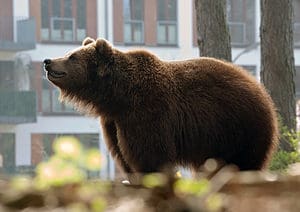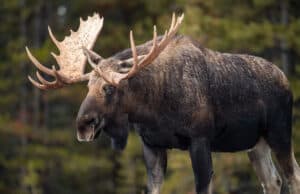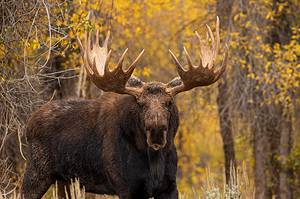Moose are the largest members of the deer family. Moose babies are not only adorable, they are miraculous mammals that can run faster than humans at just three days old. Did you know that all moose babies and their adult counterparts are born colorblind?
Keep reading to find out eight incredible facts about the moose babies and check out some heartwarming tiny moose pictures.
#8: Moose Babies Can Outrun Humans by Three Days Old
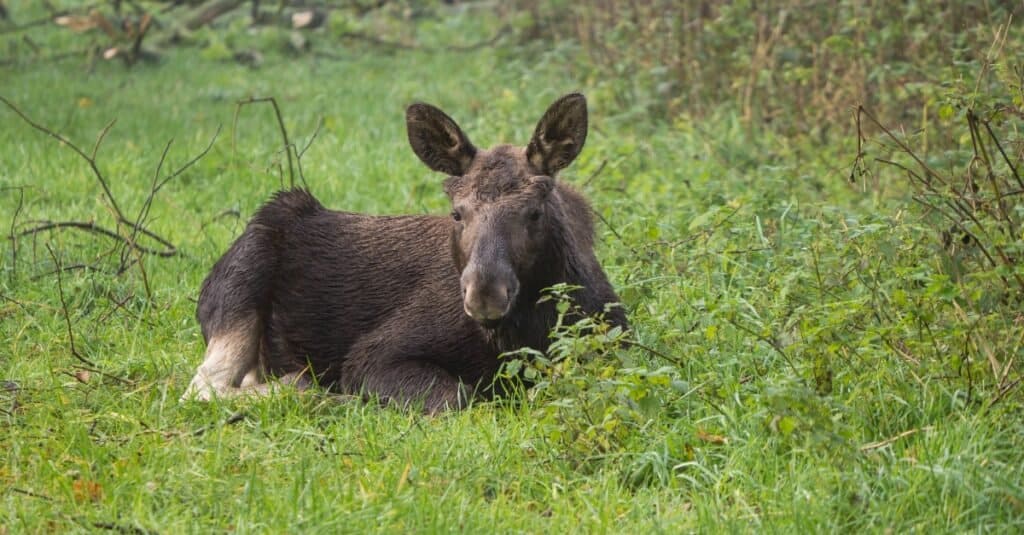
A moose calf relaxes in the grass.
©iStock.com/hipproductions
If you tried to race a moose baby, you wouldn’t have a chance of winning after the first day or two of their lives. A newborn moose baby can run faster than an adult human at just three days old! The average speed a newly born moose can run is 30 miles per hour, and they can jump anywhere from eight to ten feet.
Did you know that moose calves are also excellent swimmers? It’s true – moose babies can swim up to ten miles per hour! Their front legs are longer than their back ones, which allows them to pick up speed quickly. Mother moose, called cows, are known to take their babies into the water to evade predators.
#7: A Baby Moose is Born Weighing Thirty Pounds
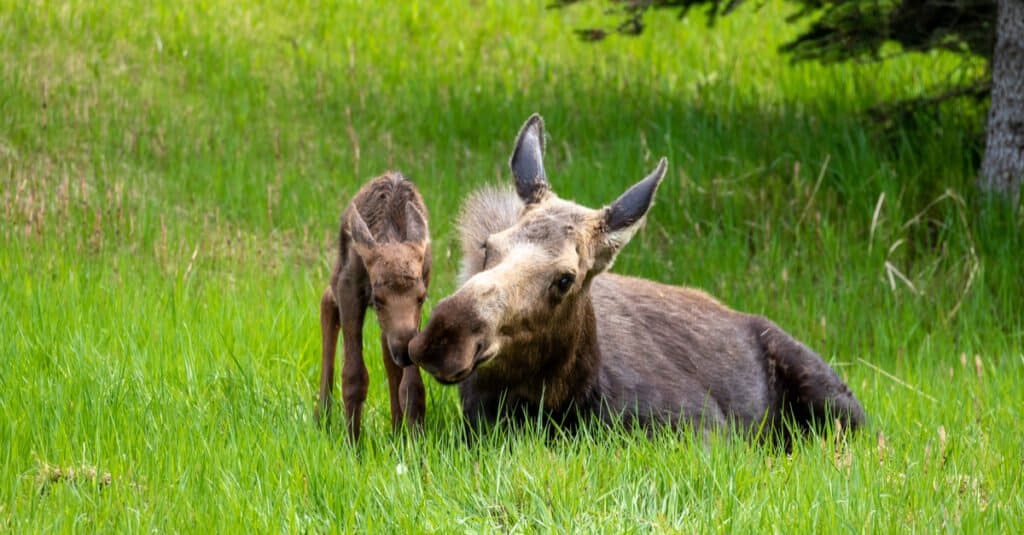
A mother moose cares for her baby.
©Mark A. McCaffrey/Shutterstock.com
Moose are born weighing around 30 pounds, but that’s not the most miraculous thing about their size. Moose twins usually weigh approximately 14 pounds each.
When they are fully grown, adult male moose can weigh up to 1,500 pounds, and females typically weigh a maximum of 1,300 pounds. The largest moose ever weighed 1,808 pounds! When they’re babies, moose pack on an estimated pound a day in the spring and sometimes up to 4 pounds daily later in the year.
In order to gain this much weight each day, moose calves eat a lot of food. In the summer, moose must consume more food to prepare themselves for the long winter. Since they are herbivores, food sources can be scarce during the cold months, so baby calves eat more in the summer than in winter.
#6: Young Moose are Called Calves and Have Bad Eyesight
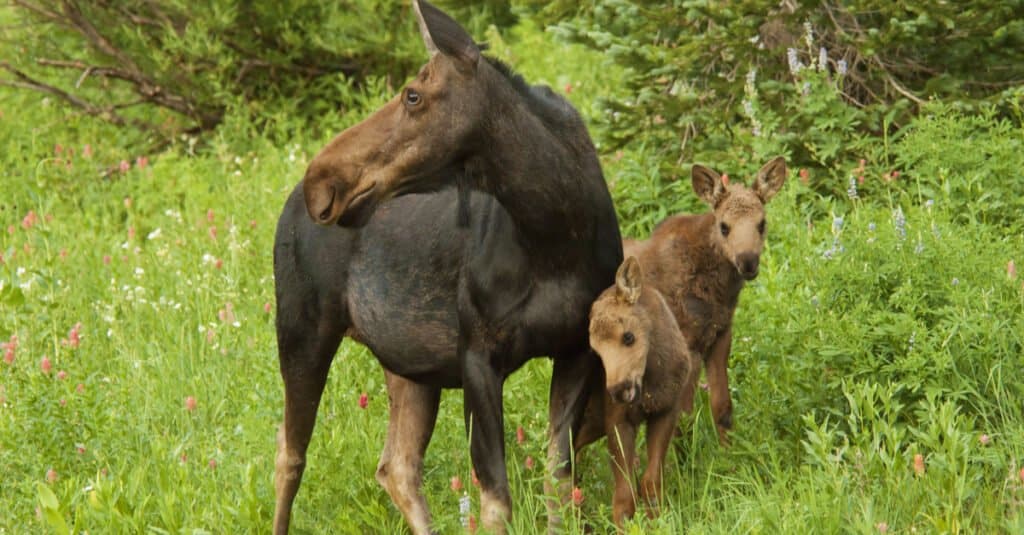
Baby moose rely on their mothers for protection.
©MintImages/Shutterstock.com
When moose are born, they have terrible eyesight. Luckily, they are born with an excellent sense of smell and sound, so they can navigate the world around them using those avenues. As they grow up, their eyesight improves slightly, but they continue to primarily use their sense of sound and smell to protect them from predators.
Moose eyes also have a shortage of cones, which are responsible for transmitting and translating colors to the brain. This means that all young moose (and their parents) are color blind.
#5: Moose Babies Cry Like Humans
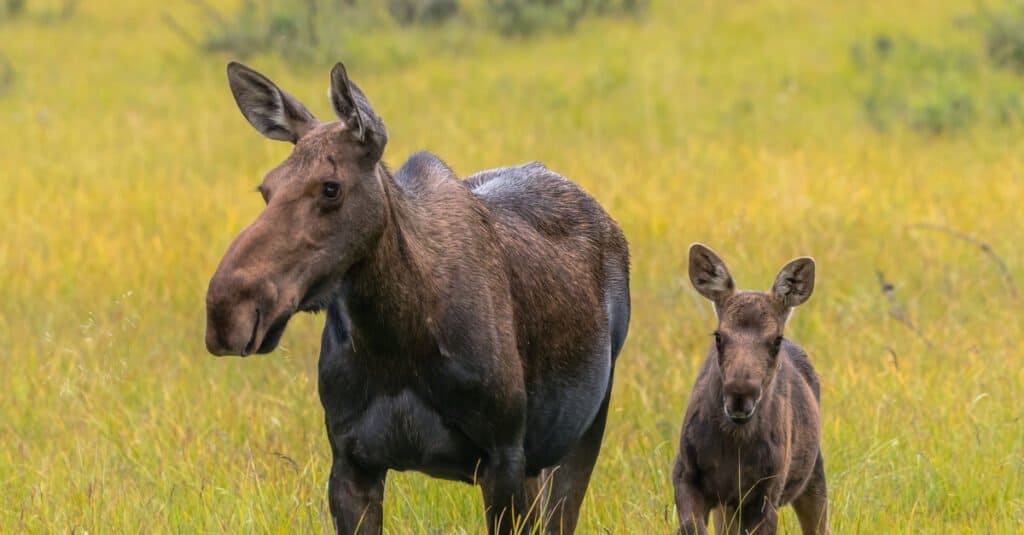
Moose calves cry for their mothers when in distress.
©Kelly vanDellen/Shutterstock.com
Baby moose are quick to vocalize when they need help or support from their mothers. When they are newly born, moose make a grunting sound to get their caretaker’s attention. As they grow older to be a few weeks old, they learn to make a wailing sound similar to a baby’s cry. Moose babies cry when they are hungry, distressed, or otherwise upset. Moose babies have been known to call when they lose sight of their mothers, as well.
#4: Moose Aren’t Born with Antlers
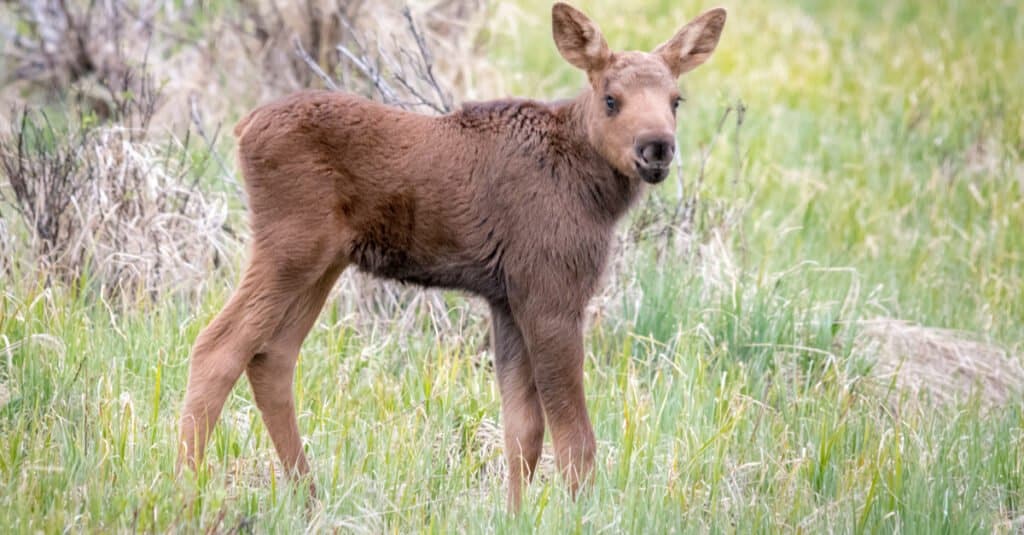
Moose calves don’t have antlers until they are around a year old.
©Eivor Kuchta/Shutterstock.com
Perhaps one of the most distinct features that a moose has is its antlers. But did you know that moose calves are not born with antlers or horns? That’s right – moose don’t start to grow their antlers until their first birthday. Until then, young moose have “buttons” on their head where their antlers will later grow in.
Antlers are made of bone and usually only have two or three points until the moose is about five years old. The number of points on a moose’s antlers determines whether they are young or old but cannot definitively determine a moose’s age.
#3: Baby Moose Are Born in the Spring
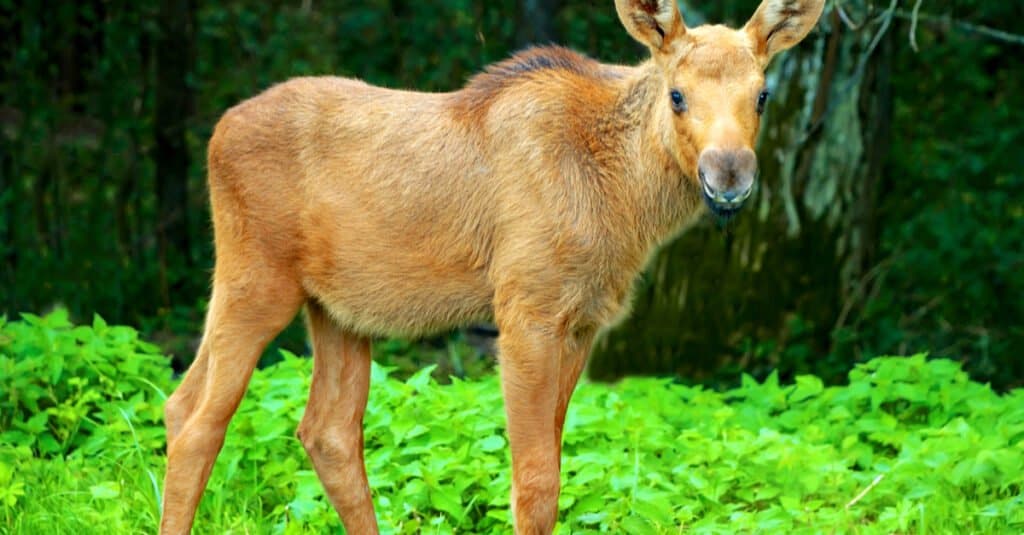
All moose calves are born in the spring.
©Volodymyr Burdiak/Shutterstock.com
All moose calves are born in the spring. Their mothers mate to conceive them sometime during the fall months of September or October and birth their young in the months of May or June. It takes eight months for a moose to become fully developed in their mother’s womb.
Most moose are singletons, but there have also been instances of twins or even triplet moose in the wild.
#2: Moose are Solitary Animals Except with Babies
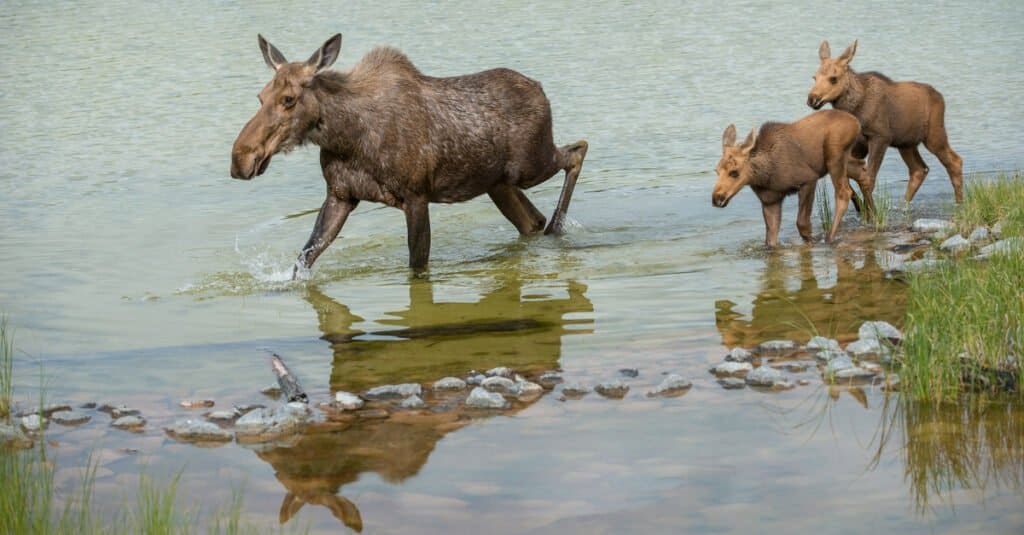
A cow moose leads her babies through the water.
©Ghost Bear/Shutterstock.com
The only group of moose you’ll see in the wild is a mother with their moose babies. Since moose are solitary animals, they only travel together with their babies to protect them from predators and teach them how to survive. When a mother moose (also called a cow) is ready to have another baby, she will start the process of ridding herself of her male yearlings.
The mother moose will usually start by ignoring her male yearlings. The young moose may charge at her and make audible noises to get her attention, but she doesn’t give in. Finally, the yearling moose venture off on their own, and the mother moose prepares to take care of a new baby. Female moose calves are known to stay with their mother for several years since cow moose don’t usually chase female calves away.
#1: Newborn Moose are Over Two Feet Tall!
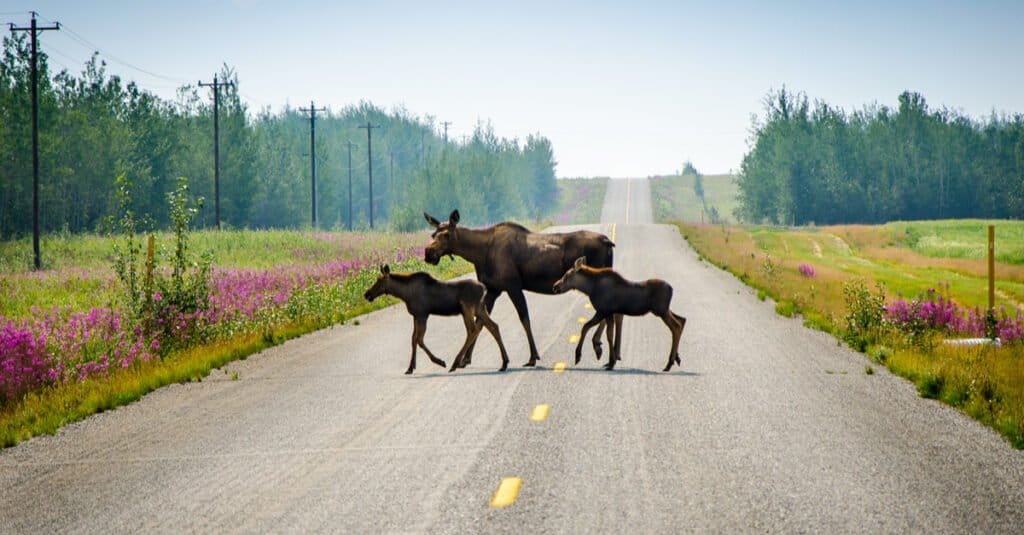
Two moose calves cross the road with their mother.
©Tracey Mendenhall Porreca/Shutterstock.com
Moose are born standing over two feet tall – that’s over three times the size of a human baby! Most of their height is in their legs, and their fur is so dark brown when they are born that they appear almost black.
Bonus: Can a Baby Moose Survive Alone?
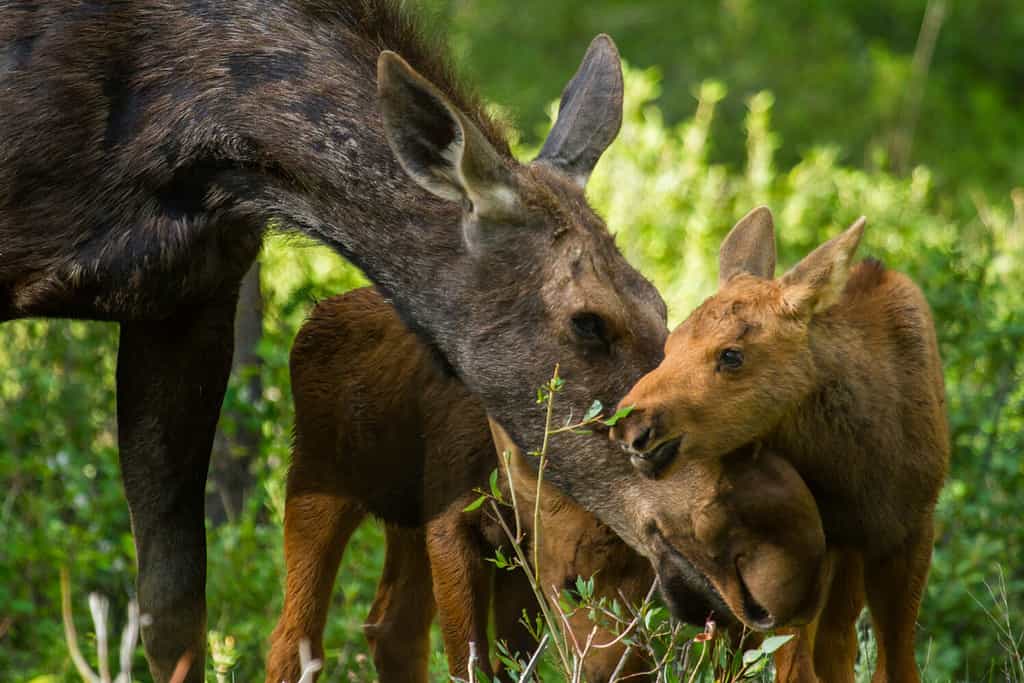
Mother moose sometimes leave their calves for a period of time to forage, but are not abandoning them.
©Green Mountain Exposure/Shutterstock.com
Baby moose are no different than many baby animals maturing in the wild. Their chances of survival are higher when they can rely on their mother’s care. Sometimes calves are left alone, even for long periods of time, usually to forage for food. There have been instances where humans observe lone calves and are tempted to approach them, either out of concern that they are abandoned, or curiosity.
Wildlife experts advise not to approach moose calves. It’s common for their mothers to leave them alone, and it’s most likely these babes have not been abandoned. However, if a moose calf has been observed to be alone for a day or more, you can call Fish and Game experts to alert them. However, the experts likely won’t rescue it, as moose calves don’t tend to fare well in captivity.
The main reason it’s a bad idea to approach a moose calf is that mother moose are protective and can get aggressive. It’s also illegal in many states.
The fact of the matter is that studies have shown that 25% of moose calves survive their first year of life. They can’t run well for their first 5 weeks, leaving them vulnerable to being chased down and killed by grizzly bears and wolves. The ones that stick closest to their mothers, allowing them to fight their battles, are the likeliest to survive.
The photo featured at the top of this post is © Eivor Kuchta/Shutterstock.com
FAQs (Frequently Asked Questions)
Which predators does a baby moose have?
Wolves, black bears, and cougars are all examples of predators that prey on baby moose.
What do baby moose eat?
For the first five months of their lives, moose calves exclusively drink their mother’s milk. Once they are weaned, they eat an herbivorous diet of a variety of fruits and plants.
Where do baby moose live?
Baby moose are primarily found in Europe, North America, and Canada. They prefer cold climates.
How big are baby moose when they are born?
Baby moose are up to 30 pounds and over 2 feet tall when they are born.
Thank you for reading! Have some feedback for us? Contact the AZ Animals editorial team.




